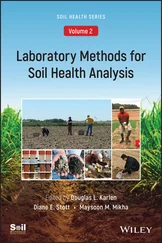Soil Health Analysis, Set
Здесь есть возможность читать онлайн «Soil Health Analysis, Set» — ознакомительный отрывок электронной книги совершенно бесплатно, а после прочтения отрывка купить полную версию. В некоторых случаях можно слушать аудио, скачать через торрент в формате fb2 и присутствует краткое содержание. Жанр: unrecognised, на английском языке. Описание произведения, (предисловие) а так же отзывы посетителей доступны на портале библиотеки ЛибКат.
- Название:Soil Health Analysis, Set
- Автор:
- Жанр:
- Год:неизвестен
- ISBN:нет данных
- Рейтинг книги:3 / 5. Голосов: 1
-
Избранное:Добавить в избранное
- Отзывы:
-
Ваша оценка:
- 60
- 1
- 2
- 3
- 4
- 5
Soil Health Analysis, Set: краткое содержание, описание и аннотация
Предлагаем к чтению аннотацию, описание, краткое содержание или предисловие (зависит от того, что написал сам автор книги «Soil Health Analysis, Set»). Если вы не нашли необходимую информацию о книге — напишите в комментариях, мы постараемся отыскать её.
Soil Health Analysis, Set — читать онлайн ознакомительный отрывок
Ниже представлен текст книги, разбитый по страницам. Система сохранения места последней прочитанной страницы, позволяет с удобством читать онлайн бесплатно книгу «Soil Health Analysis, Set», без необходимости каждый раз заново искать на чём Вы остановились. Поставьте закладку, и сможете в любой момент перейти на страницу, на которой закончили чтение.
Интервал:
Закладка:
Interpretation of Soil Health Information
Several nationally appropriate tools, including the Revised Universal Soil Loss Equation (RUSLE), Soil Conditioning Index (SCI), Water Erosion Prediction Project (WEPP), Wind Erosion Prediction System (WEPS), AgroEcosystem Performance Assessment Tool (AEPAT), and Soil Management Assessment Framework (SMAF), have been developed to help interpret soil health related data (USDA‐NRCS, 2019b). RUSLE2 estimates soil loss due to rill and inter‐rill erosion caused by rainfall on cropland (Renard et al., 2011; USDA‐ARS, 2015). The SCI combines information from the soil tillage intensity rating tool (STIR), a N‐leaching index, and Version 2 of the Revised Universal Soil Loss Equation (RUSLE2) to provide information to producers regarding how their management decisions are affecting their soil resources and is widely used in NRCS conservation planning. AEPAT is a research‐oriented index methodology that ranks agroecosystem performance among management practices for chosen functions and indicators (Liebig et al., 2004; Wienhold et al., 2006). Water Erosion Prediction Project (WEPP) is a process‐based, distributed parameter, continuous simulation, erosion prediction model for use on personal computers (USDA‐ARS, 2017); Wind Erosion Prediction System (WEPS) predicts many forms of soil erosion by wind including saltation‐creep and suspension (USDA‐ARS, 2018). Without question, wind‐, water‐, and anthropogenic‐induced soil erosion continues to be a global problem (Karlen & Rice, 2015) and must be the first factor mitigated to truly improve soil health, as it is an advanced symptom of degradation including loss of soil organism habitat, stable aggregation, and other critical soil functions.
Soil health indicator measurements, when coupled with an available assessment framework, complement soil erosion tools as they can directly and more definitively detect less advanced symptoms of soil health degradation across diverse management systems. Laboratory data, without field‐level information can be difficult to interpret or use for management decisions, and should only be used when supplemented with qualitative, in‐field assessments of SH and an understanding of the past and current management system in use.
Data collected over time from the same field can be used to monitor soil health, but this may take a long time to be of value to producers or organizations, as it requires establishing a baseline and sampling over a number of years. Use of soil health assessment frameworks allow single field indicator measurements to be interpreted and used for decision making by leveraging a wealth of research conducted over the last 50 yr and continued targeted data collection. The first such framework (SMAF;) was developed collaboratively between ARS and NRCS (Andrews et al., 2004). Stott et al. (2010) and Wienhold et al. (2009) improved the SMAF by providing additional indicator scoring curves, thus improving its utility for both crop and pasture lands. SMAF uses broad soil taxonomic groups (suborders) as a foundation for assessment and allows curve modification based on inherent soil suborder characteristics. This is often essential as a contextual basis for indicator interpretation.
By design, SMAF assessments are soil‐ and site‐specific, because they depend on soil, climate, and human values such as intended land use, management goals, and environmental sensitivity. A purported SMAF strength is that all of those factors can be manipulated by the user (primarily researchers). This will cause subtle changes in the scoring curves, causing some to argue that is not an advantage because it makes the process too complex for producers and their service providers. The approach taken by the SMAF was thereafter adapted for high throughput, public laboratory soil health testing in New York State by Idowu et al. (2008). The Comprehensive Assessment of Soil Health (CASH) was designed to evaluate soil functioning with respect to crop production and environmental impact and provide producers with a soil health status report similar to soil fertility reports commonly provided by soil testing labs. Most scores are effectively percentile ratings, comparing a measured value to the known population distribution in a soil textural group. CASH was based on the SMAF but used indicator methods with faster analytical procedures to accommodate a high‐throughput lab setting. Furthermore, CASH was originally developed solely for New York, so scoring functions varied by texture, but were not adjusted for any other inherent soil characteristics associated with taxonomic classification or climate.
The framework approach for interpreting measured soil health data is further discussed in Volume 1 ( Chapter 5). In summary, both SMAF and CASH provide efficient comparisons of similar soils under diverse management and estimates regarding the level of functioning of a particular field within the overall soil health continuum (van Es & Karlen, 2019). The key to robust interpretations is being able to compare soil samples from both agricultural and non‐agricultural ecosystems, as well as for different soil and crop management practices, using consistent, standard, methods.
Utilizing Soil Health Assessments to Inform Soil Management Decisions
It was stated in the Foreword to Doran et al. (1994) that “scientists and lay persons have long recognized that the quality of two great natural resources– air and water– can be degraded by human activity. Unfortunately, few people have considered that the quality of soil can also be affected by differing uses and management practices. Interest in soil quality has heightened during the past 3 yr as a small cadre of soil scientists became more concerned about the role of soils in sustainable production systems and the linkages between soil characteristics and plant‐human health.” This reflects just one early step in the exponential progress made during the past three decades that has led from soil quality being a research niche to broad awareness of the critical importance of healthy soils to agriculture and societies in general.
Soil health considerations are currently being incorporated across the activities of many agriculture‐serving organizations nationally. For example, it has been incorporated into NRCS conservation planning and implementation programs. New soil health resource concerns, or constraints that can be documented by conservation planners, were published (USDA‐NRCS, 2020a). These are also being embedded into key Conservation Practice Standards (USDA‐NRCS, 2020b), a series of documents describing which constraints structural and agronomic conservation management practices can address, as well as the criteria for how to implement these practices to facilitate resolving identified constraints. Guidance is being updated to further reflect the current science on the importance of systems approaches as well, starting with crop lands, with plans to expand guidance available for other land uses. Standardization of measures is being undertaken across multiple organizations to build basic capacity to better inform management decisions and to quantify transition times and outcomes of soil health management systems implementation (USDA‐NRCS, 2019b; Norris et al., 2020).
To fully address resource concerns and build fully functional soils, by improving organic matter quantity or quality, reversing soil organism habitat degradation, alleviating compaction, or improving soil aggregate stability, an agricultural annual cropping system that properly incorporates more than one soil health‐targeted conservation practice is usually needed (Basche & DeLonge, 2017; Congreves et al., 2015; McDaniel et al., 2014; Turmel et al., 2015; USDA‐NRCS, 2019a). Through the NRCS conservation planning process, conservation practices (USDA‐NRCS, 2020b) for cover crops (340), crop rotation (328), and reduced‐ or no‐tillage (345 and 329) are regularly employed by conservation planners to address various resource concerns since the methods of soil and crop management they represent are important contributors to sustainable agricultural production systems. However, if used in isolation, it is unlikely that a single practice will provide lasting SH benefits through improved SOM or the critical soil functions associated with SOM. For example, incorporating a cereal rye cover crop into a two‐crop rotation that is dependent on frequent tillage may provide some weed suppression benefits or help reduce erosion, but it is unlikely that soil aggregate stability will be improved. Realizing improvement in soil function through management changes will typically require the strategic and simultaneous use of multiple practices. To better understand potential interactions among practices it may be helpful to think of their roles with regard to each of four broadly applicable NRCS soil health principles: minimizing soil disturbance, maximizing soil cover, maximizing biodiversity, and maximizing the presence of living roots. Each principle can be implemented using soil and crop management practices designed to address existing soil health concerns and maintain soil function. Depending on the cropping system, each soil health principle can be achieved through appropriate use of one or more conservation practices. Achieving all four principles by thoughtfully implementing and adaptively integrating multiple, complimentary conservation practices known to address identified constraints or concerns is the best way to ensure that soil health constraints are alleviated through synergistic effects as illustrated below.
Читать дальшеИнтервал:
Закладка:
Похожие книги на «Soil Health Analysis, Set»
Представляем Вашему вниманию похожие книги на «Soil Health Analysis, Set» списком для выбора. Мы отобрали схожую по названию и смыслу литературу в надежде предоставить читателям больше вариантов отыскать новые, интересные, ещё непрочитанные произведения.
Обсуждение, отзывы о книге «Soil Health Analysis, Set» и просто собственные мнения читателей. Оставьте ваши комментарии, напишите, что Вы думаете о произведении, его смысле или главных героях. Укажите что конкретно понравилось, а что нет, и почему Вы так считаете.












